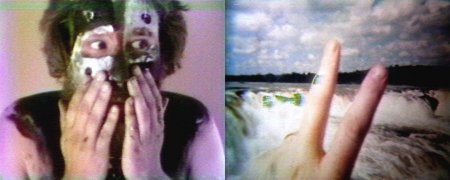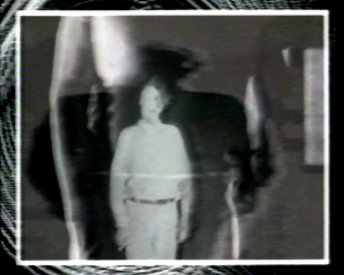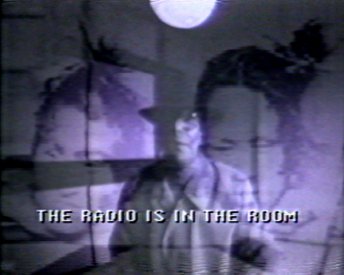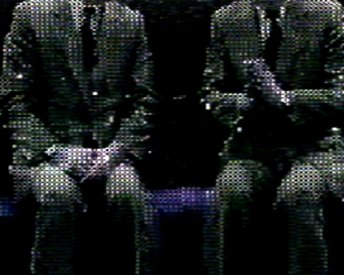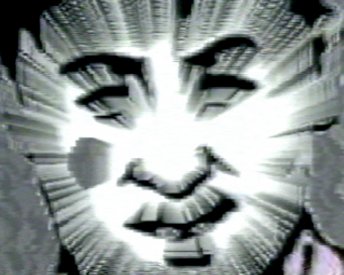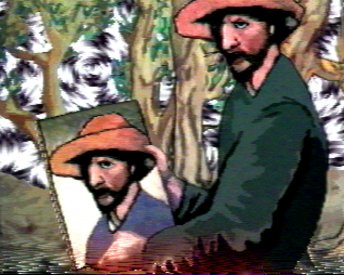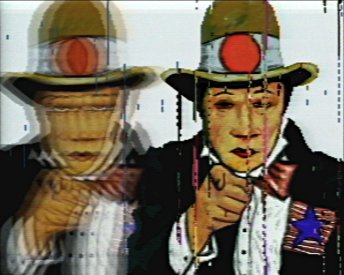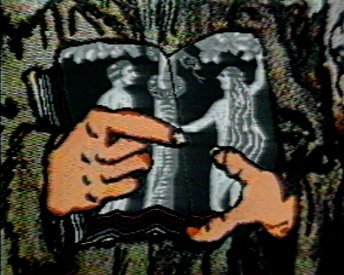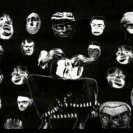Peter Callas: Initialising History was a 20 year retrospective centered on the work of Peter Callas, one of Australia's most distinguished electronic media artists, curator and writer.
It toured Australia and internationally, with exhibitions at
- “Articulations” Perth Institute of Contemporary Art, The Festival of Perth (1999)
- The Australian Centre for Contemporary Art, Melbourne (1999)
- The National Gallery of Australia, Canberra (1999)
- The Art Gallery of NSW, Sydney (1999)
- 24 Hour Art, Darwin (1999)
- The Third Asia-Pacific Triennial of Contemporary Art, Queensland Art Gallery, Brisbane (1999)
- Biennale of Art and Communication, Rome (1999)
- Salamanca Arts Centre, Hobart (May, 2000)
- Shilpasamannaya Centre, Chittagong, Bangladesh (2002)
Peter Callas Initialising History: video works 1980-1999 (selected by the artist)
Peter Callas' award-winning works have been widely exhibited and screened nationally and internationally - in galleries, museums and screened nationally and internationally - in galleries, museums and festivals, and also broadcast on television stations such as BBC2 London, Canal + Paris, and NHK Satellite Tokyo. Several of Callas' works have been acquired for collection by many art institutions, including Centro de Arte Reina Sophia, Madrid; The Museum of Modern Art, New York; and National Gallery of Australia, Canberra.
"This retrospective of Callas' video art traces a trajectory from his earliest performative works of 1980 through the dynamic image landscapes of the 1980s and 90s. Throughout, Callas explores the layering and distortion of history and narrative, the relation of media and technology to cultural and personal identity [...] Resonating at once with humor, dislocation and loss, Callas' vivid surfaces serve as an ironic yet poignant illuminated manuscript, a brilliantly illustrated map of global media in the late twentieth century."
- Lori Zippay, Director, Electronic Arts Intermix, New York. Excerpt from monograph introduction, dLux Media Arts 1999 Sydney
Video Notes, Rachel Kent (Curator, The Ian Potter Museum of Art, The University of Melbourne - all notes, except for Lost in Translation)
Singing Stone, colouriser work 1980 Sydney 4:22
A hand clutches an oval stone which is drawn back and forth in tight circular motions, grinding pigment. Produced with a black and white half inch reel-to-reel portapak video recorder (manufactured c1975), Singing Stone demonstrates Callas' early experimentation with colouriser painting techniques. The effect is one of visual distortion in which pictorial surface and depth oscillate, creating a sense of dislocation and hallucination.
Our Potential Allies, dual monitor installation 1980 Sydney 15:00, reconfigured for a single screen 1999 excerpt 5:00
Our Potential Allies is an intuitive and ironic critique of Eurocentric belief-systems founded upon the dichotemy of self (the West) and the Other. Callas appears on the left monitor in black and white facial paint - the so-called 'mask of primitivism' - while compressed news imagery appears upon the right. Facial gestures are enacted by the artist seemingly in response to the voice-over (instructions issued by General Douglas MacArthur to American soldiers fighting in Papua New Guinea during the Second World War) or to imagery on the right monitor. Questions of intent - a constant theme throughout Callas' career - are thus raised in relation to the creation of apparently random meaning.
How to Make the Famous Pico Sour: A Videotape in Three Locations, performance video 1982-1986 Sydney/Tokyo 16:10
Pico Sour represents a shift beyond earlier works in its dense layering of subject-matter and imagery. Inititated in Australia and completed in Japan, the work draws upon the core imagery of a bullock dray, a male figure in the silhouette, a Japanese mask and a bottle of Pico Sour. These appear in varied permutations alongside other seemingly random images to form a series of telescopic views (screens with screens) which allow the viewer to move back and forth between different visual planes. Verbal narrative and textual statement create a sense of tension whilst suggesting that history and emaning are never fixed. As Callas has noted, the work presents something of a conundrum, its title suggests a metaphoric recipe for the potential 'souring' of things.
Kiru Umi No Yoni / Cutting Like the Ocean, installation document 1983-86 Tokyo/Hobart/Tokyo 22:00 excerpt Parts III and IV 4:23
One of Callas' most personally confronting works. It is made up of six parts, and utilises the image of a knife slicing horizontally through the pictorial screen as its central and linking motif. Its starting point is an installationby Callas which incroporated a photograph from the 1920s of two severed heards belonging to a male and female of the Takasago tribe in Formosa (taiwan). At once horrific and enigmatic, this image forms a potent metaphor for Japan's pre-Second World War imperial past. In its focus upon colonial history and collective memory, the significance of the work is not confined to Japan alone but offers a kind of mirror with which to face atrocities committed in colonial Australia.
Double Trouble, Fairlight CVI work 1986 Tokyo 5:45
On eo fthe earliest works made by Callas using a fairlight Computer Video Instrument (CVI) processor, a pioneering compositing and special effects system he utilised regularly from the mid 1980s to early 90s. The CVI was a hybrid of video and computing technologies which enabled low resolution copmuter-like effects to be produced 'live' without rendering. Double Trouble is rhe first video made by Callas for a large exterior street screen format (in Tokyo). The image appears as though spliced into vertical halves, an array of imagery and characters appearing in double on ether side of the division, and moving with alternating motion upwards and downwards. This two-frame animation technique creates two images from one checkerboard stencil which are then reversed, or asynchronously 'mirrored', producing an apt metaphor for cultural differences in 'body language' between East and West.
Kinema No Your / Film Night, CVI works 1986 Tokyo 2:30
The first almost entirely 'animated' work within the current exhibition, Kinema No Yoru introduces he motif of the menko playing card as a recurrent symbol. Popular amongst Japanese children, menko's colourful appeal is underscored by a darker ideological bias in the set of cards at Callas' disposal. Disjunctive images of war and territorial conquest (human bombs, brave feats, gas masks) thus convey more about Japan's colonial aspirations than of the game's competitive nature in the simple winning and losing of the iconic cards. The introduction of political and propagandist imagery reflects the artist's profound scepticism toward notions of universal truth and authenticity of experience.
The Esthetics of Disappearance, CVI work 1986 Tokyo 6:05
This work, which takes its title from Paul Virillo's publication of the same name, explores notions of the cinematic in relation to recent global history, with particular focus on the role of the media in conveying information and events into the home via the medium of the television. Virillio's thesis upon cinema and temporal experience proposed that 'with the cinematic accelerator [...] the measure of the world becomes that of the vector of movement, of the means of locomotion that desynchronize time'. Notions of heightened speed and the distortion of perception are conveyed visually in the work by the rapidity of images and their intense colouration - elements that have come to represent key characteristics of Callas' mature style.
If Pigs Could Fly (The Media Machine), CVI work 1987 Tokyo 4:20
Produced for the Bicentennial Travelling Exhibition which circumnavigated Austrlia during the 1988's 'celebration of a nation', this work representa a return of a nation', this work represents a return by Callas to distinctively Australian imagery: the Anzac, a kangaroo playing the fiddle, the swagman, the the surface. These patriotic and nationalistic icons are intercut with references to contemporary media culture to reflect process of 'cultural de-territorialisation', brought about by the advancement of communication technologies in the late 20th century. The irony of the natinoal media promoting and perpetuating the notion of a unitary, cohesive Austrlia identity is a nation made up of multiple racial and ethnic groups, and founded on a largely unresolved colonial past, is not lost on Callas.
Night's High Noon; An Anti-Terrain, CVI work 1988 Tokyo 7:26
Created amidst Austrlia's 1988 bicentenary celebrations, Night's High Noon proposes a flipside to stereotyped notions of recent Australian history and identity. For Australia's Aboriginal peoples the Bicentenary represented two hundred years of dispossession from their land, culturald destruction and racial prejudice. Representation of indigenous cultures allude to the appropriation and objectification of Aboriginal peoples, their artforms and traditions, in white Australian popular culture. Truth and Meaning are similarly problematised.
Neo-Geo: An American Purchase, CVI work 1990 New York 9:17
Neo Geo was produced by Callas during an artisitc residency at PS1 Studio in New York in 1988-89. It exposes the profound contradiction inherent in the twin gods of contemporary American culture - capitalism and democracy - by intense layering of diverse visual cues and associative references drawn from popular culture, the entertainment industry, religion, warfare and technology. The effect is one of visual and aural overload, culminating with the screaming sound of falling bombs, guns and thunder, accompanied by images of war and death. A postmodern Babylon, America is portrayed here at bursting point.
Bilderbuch für Ernst Will (Ernst Will's Picture Book): A Euro Rebus, CVI and Quantel Harriet work 1990-1993 Sydney/Tokyo 11:00
The most complex and multi-layered of Callas' CVI works, Bilderbuch focuses on the geographic continent and turbulent political history of Europe. The primary image source of the work is a children's wartime pictorial scrapbook (or bilderbuch). Callas has described Bilderbuch für Ernst Will as an 'electronic rendering of a form of proto-televisual iconmania' involving the collecting and collating of seemingly random images which, when seen together, revel underlying narratives and belief-systems. Seen in this context, images from the child's scrapbook come together to create a startling picture of wartime Europe and legacy.
Lost in Translation, computer animation work in progress music by Robert Moss 1999 Karlsruhe/Brazil/Sydney 6:00. Produced in association with the Australian Film Commission.
"The double movement of displacement and circulation, loss and regeneration, constitutes a means of uncovering the disjunction between history and memory [in Latin America]". - Charles Merewether.
"This work attempts to syncretically avaunt the 'borders of identity' in an anti-historical reconstructed of 'Brazil'." - P Callas
Acknowledgements
Peter Callas expresses particular thanks to: Alessio Cavallaro, dLux Media Arts; Michael Goldberg, Tokyo; Yoicho Kajima, Ringworld, Tokyo; Fujiko Nakaya, Video Gallery Scan, Tokyo; Emiko Namikawa, Gallery Lunamia, Tokyo; Rachel Kent, Melbourne, Bernice Murphy, Sydney.
For Lost in Translation, the artist also gratefully acknowledges the assistance of the Visual Arts/Craft Fund of the Australia Council for the Arts; Softimage Inc, Canada; ZKM Centre for Art and Media, Karlsruhe; Greenworks (Xfrog software); Australian Film Television and Radop SChool (Flame); and Jay Seabold, Hispanic and Portugese Collections of the Library of Congress.
Special thanks to Morris Averill, Filmlaw & Cyberlaw; Michael McMahon, Arts Law Centre of Australia; and Anna Ward, National Assosciation for the Visual Arts.
Thanks also to the Judy Ammear, Jean-François Beauchamp, Alfred Birnbaum, John Colette, Sueanne Day, Solange Farkas, Rudolph Frieling, Stephen Jones, Yuri Kawanabe, Sandra Kogut, Bernd Lintermann, Jon McCormack, Dr Scott McQuire, Sam Samai, Eder Santos, Lyndon Sayer-Jones, Jeffrey Shaw, Rejane Spitz, Stephen Vitiello, Tamás Waliczky, Gary Warner, Lori Zippay

